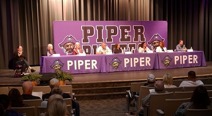Navigating Roadblocks: A Guide to Successful Client-Connected Projects in the Arts and Other Non-Traditional Environments
Written by: Tori Denault, Piper US 203
Embarking on client-connected projects in the arts is a transformative journey for both educators and students. Admittedly, it is easy for teachers to think that this work does not apply to their courses because our calendars are already full preparing for set performances and competitions. As a group of dedicated teachers, we have navigated the challenges and triumphs of integrating real-world clients into our creative spaces.
In doing so, we realized that the arts are some of the originators of integrating real world learning strategies into student experiences.
Turning this intuitive work into official client-connected projects was truly rewarding and invigorating for everyone involved. Embarking on client-connected projects opens doors for students to authentically showcase their creativity while navigating real-world challenges. Here is a glimpse into our experiences and the roadblocks we faced, along with insights into how to overcome them.
Case Studies
Belton High School Theatre

Belton High School took their pre-existing Improv Shows and turned them into a client-connected project. The theatre instructor became the client, charging her students with crafting and producing the productions. Students engaged with Tim Marks from the KC Improv as a subject matter expert to ask questions and obtain information about running their own improvisation show. Finding engaging subject matter experts to provide students feedback on their projects became a vital part of ensuring that the work stayed rooted in the principles of Real World Learning.
One of the biggest challenges students faced was effectively managing their time. A required deliverable has to be a firm timeline of deadlines and events. Students need frequent checkpoints so that the hard deadline is not so problematic. Although procrastination is a part of working with students in all areas, its effects reach much further when working on a community performance.
Piper High School Debate

Debate students at Piper High School worked with our district office to create a school-board- candidate forum to help drive community engagement prior to elections. Students generated candidate questionnaires, published a custom-built website to communicate the responses, and facilitated the forum for the community. The candidate forum served as the sole point of direct comparison for the community and directly impacted the results of the election.
One of the challenges students faced in bringing the forum to life was learning to manage our client’s expectations. Some clients really struggled with relinquishing control of the project to students. They wanted students to complete tasks for them but did not allow students to have autonomy over the problem-solving process. In the future, this misalignment of expectations can be mitigated by communication with clients from Real World Learning coordinators from the outset (before students are involved).
Shawnee Mission Schools
Several teachers from different Shawnee Mission high schools worked to implement client-connected projects in their curriculum. One gifted education instructor allowed students to work on projects as a way of meeting their IEP goals. In this method, the teacher served as a project manager for several smaller projects, spanning from esports to nonprofit organizations to independent theater performances. By allowing students to pursue individual passions, each student’s voice was valued and allowed to grow.
Another instructor with the Shawnee Mission Graphic Design program is guiding students in designing signage for our Outdoor Education Lab (SMESL). This is an ongoing project for future classes as well because of the proposed growth and improvement of the SMESL.
Working on such a variety of projects inevitably led to diverse roadblocks. When working with individual community organizations, technology frequently became an issue. One non-profit organization wanted to use a PC-only application. We had to problem-solve with the IT department for the student to be able to access the program. Navigating technology with outside clients is frequently an issue that students need to troubleshoot from the beginning of a project and can be one of the most frustrating hurdles that students face. Students are not used to having to think about systems compatibility or being able to access digital resources.
Kearney High School Case Study
Choir students at Kearney High School embraced many different client-connected projects throughout their courses. From filling community needs for singers to learning and training others on the utilization of sound equipment, choir students are actively utilizing their skills within community contexts. One of the most exciting projects students completed was for the Kearney Chamber of Commerce. Students wrote and recorded a Jingle for their “Keep the Cheer Here” campaign for community involvement during the holiday season. A rough draft of the project can be heard HERE
Additionally, several students are currently working on a Musician’s Entrepreneurial Experience. Students conduct market research on how gigging artists function within a community and develop products such as demos, setlists, and pay scales to support those endeavors. Students work closely with subject matter experts to group this work. Students engage with working artists to get feedback on their music to help influence their product development.
As with any project, communication was a key roadblock students faced. Frequently, students wanted to plunge into creative work, but they needed to wait for input from their clients and subject matter experts. In future iterations of the project, we will place a greater emphasis on communication with students and timely responses.
In conclusion, the journey of implementing client-connected projects in the arts is marked by challenges that, when navigated thoughtfully, lead to profound conclusions, the journey of implementing client-connected projects in the arts is marked by challenges that, lead to profound educational experiences. These examples illustrate the diverse ways in which arts students are engaging with real-world projects, overcoming challenges, and leaving a lasting impact on their communities. By connecting creativity with practical skills, educators are nurturing a generation of artists who are not only talented performers but also versatile contributors to the cultural and civic fabric of their communities.
